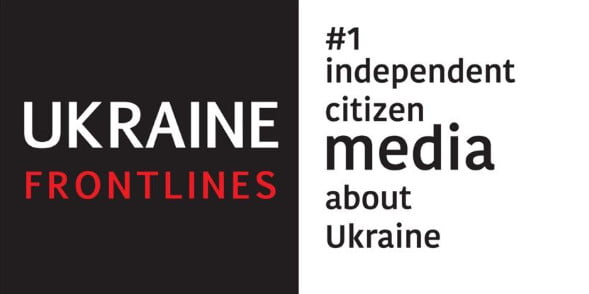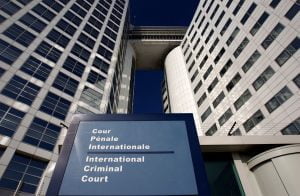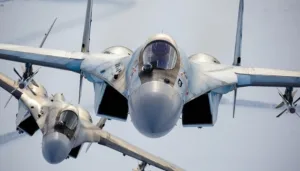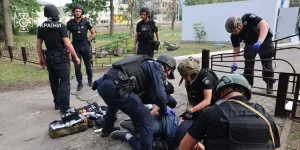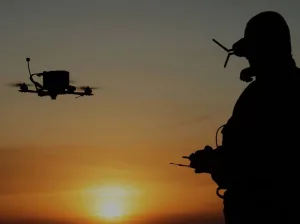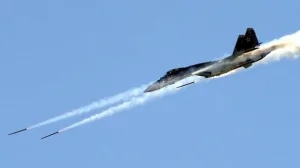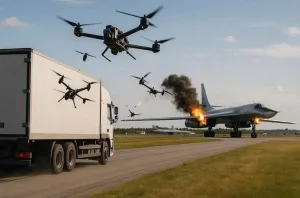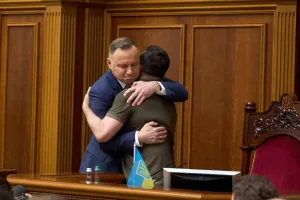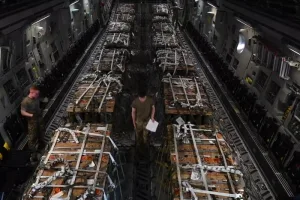Serhii Naiev, Lieutenant General, Commander of the Joint Forces of the Armed Forces of Ukraine, outlined his chronology of events on the eve of the full-scale invasion and the first months of resistance to the Russian-Belarusian military aggression. In his account of the events, he uses such phrases as “we managed to foresee,” “my inner feelings,” “my prediction was right.” This makes us conclude that the Ukrainian people can owe their lives to the professional Ukrainian military, their experience and feelings, on which the defense of Ukraine was built in the early days of the full-scale invasion.
We were lucky that the “wise war-weary Ukrainian people” did not choose green lieutenants from amongst the Kvartal 95 partiers for these key military positions. There have been enough victims because of ignorant people in other key political positions, including one of the most important security structures – the SBU.
We already know that in mid-January 2022, CIA director William Burns told Zelensky about Moscow’s plans for an invasion. According to the CIA, the Russian invaders were supposed to cross the border from Belarus (the aggressor country) in order to reach Kyiv quickly. The Russian military planned to attack Kyiv, land in Hostomel, block the capital and remove the top leadership of the country with the help of sabotage groups.
And it wasn’t the first visit of the CIA director to Kyiv. Burns visited Kyiv in October and November 2021.
Ukrainian commanders’ successes have already been recognized by international military experts
War, from a civilian’s viewpoint, is continuous heroic efforts of millions of people at the front and in the rear. But for a military person, a war consists of stages and separate parts – military operations. For example, a strategic military operation is an operation, the implementation of which has a significant impact on the course of the entire war. The implementation of strategic tasks affects the general strategic situation, which affects all the Armed Forces of Ukraine, the entire territory of Ukraine or most of it.
The strategic task is important for the further armed struggle in general or the preservation of Ukrainian territory overall. The implementation of a strategic task has a significant impact on the course of the entire war.
During the resistance to the Russian invasion, the Command of the Joint Forces of the Armed Forces of Ukraine developed and implemented five strategic operations.

OPERATIONAL DEPLOYMENT OF THE DEFENSE FORCES
The very first strategic task implemented even before the start of a full-scale invasion on February 24 was the operational deployment of the Defense Forces. At that time, there were 5 land groups, one Air Force group, and groups of various forces at sea under our command. However, they all were staffed in accordance with peacetime conditions.
In order to respond to the threat of an enemy invasion, which was already openly discussed, on February 23, I gave a written order to all commanders of the groups to conduct an operational deployment and transfer units and detachments to the operational areas. After that, joint military brigades were deployed in designated areas, and later – intelligence, operational, logistical, and medical support systems. In the future, this became the basis for the actions of the Defense Forces of Ukraine to repel the armed aggression of the Russian Federation.
If we hadn’t done that, we would have met the war in barracks and on training grounds. Since February 24, when the mobilization to the Defense Forces began, we started to reinforce the troops. At least one territorial defense brigade and a reserve corps were deployed in each region. This allowed us to inflict damage on the enemy and thus weaken itsoffensive potential.
PREDICTION OF THE DATE AND TIME OF THE ATTACK
We managed to foresee the date and time of the aggressor’s invasion, which allowed us to get ready for it. Although the intelligence agencies of Ukraine did not provide clear information in any of the official documents regarding the specific date and time of the start of the aggression, on February 21, I ordered commanders of all ranks to deploy troops for repelling armed aggression. And on February 23, I gave a written order.
My intelligence chief confirmed the possibility of an escalation, and my inner feelings told me that the invasion could happen on the 24th. Therefore, I immediately summoned all seven commanders of the groups and ordered them to put the troops on to combat readiness to repel aggression by 4 a.m. on February 24.
On February 23, 2022 at approximately 2:30 p.m, the Defence Intelligence of the Ministry of Defence received clearinformation that the Russians had planned to launch a full-scale war against Ukraine on February 24.
“The Russians repeatedly rescheduled the date.They postponed it for 1-2 days.But on February 23, at about 2:30 p.m., we clearly received information that they would start at four in the morning and how they would start. The information was conveyed to the first person of the state. He gave an order. But just count, there was not much time left until 4 a.m.,” Budanov said.
According to the Defence Intelligence chief, on February 23, 2022, he and his wife were already living in the military intelligence building.
“We moved into the office, went to bed, talked and waited. Then I fell asleep. At about 3:30, the head of the President’s Office called me and said: “Well, it’s already 3:30, and everything seems to be calm. Maybe everything will be okay?” I answered: “Well, let’s hope for the best, but I doubt it.”And we talked until almost four o’clock,” Budanov said.
At 2 a.m, a few hours before the full-scale war started, I arrived at the command center, where heads of all centers and departments had already gathered, and ordered them to take their workplaces and be ready for combat control. And in a few hours it became clear that the prediction was right.
THE BLACK SEA REMAINS UKRAINIAN
The third strategic task solved by our Command was disruption of the enemy’s plans to gain complete control over the Ukrainian coast of the Black Sea. Early in March 2022, the intelligence chief reported abot the enemy’s plans to launch an offensive through Voznesensk along the administrative border of the Mykolaiv and Odesa regions up to the border with Moldova the next day. After consulting the intelligence chief, I ordered the commander of the operational command “South” of the Ground Forces of the Ukrainian Armed Forces, Major General Andrii Kovalchuk, to transfer part of the troops to the Voznesensk area, and the head of the fire attack group, Colonel Vitaliy Pakhomov, to deploy all fire attack means (artillery, aviation) so that maximum damage on the enemy could be inflicted.
The intelligence analysis proved to be true – the enemy began advancing towards Voznesensk the following morning. But a unit of paratroopers of the 80th separate assault brigade met the occupiers there and kept destroying their armored vehicles and personnel for more than a day. Our artillery and aviation concentrated by the Defense Forces in this sectorbegan to crush the rest of the enemy units that tried to advance.
The very first enemy tank, which was moving across the bridge near Voznesensk, was blown up together with the bridge, and part of the enemy forces was actually blocked. Up to ten enemy battalion-tactical groups constantly tried to find a way to bypass Voznesensk.
If the enemy had managed to pass through Voznesensk and further along the administrative borders of the two regions up to the border with Moldova, Russia would have had the opportunity to land a naval assault on the territory of the Mykolaiv and Odesa regions. And it would have enabled the enemy to occupy not only the coastal cities of Mykolaiv and Odesa, but also the entire regions.
In this case, Ukraine would have been deprived of access to the Black Sea; the ports in Odesa, Chornomorsk, Yuzhny, Reni wouldn’t have operated. Our economy would not have been able to withstand that.
But all the enemy battalion-tactical groups, which were in the area of Voznesensk, Nova Odesa and Bashtanka, came under Ukrainian defenders’ heavy fire. Our aircraft carried out 5-6 combat flights each, artillery spared no ammunition. As a result, the enemy suffered such heavy losses during 6 days that they was forced to abandon the offensive.
Note. Myrotvorets.news. Here it’s worth mentioning the appalling preparation of the political leadership of the state, in particular, the criminal inhibition of producing divisions of the ground version of the RK-360MC Neptun missile system.
The terrible state of the defense industry at that time led to the fact that our courageous Ukrainian soldiers had to amaze the world with their unprecedented military operations, and Ukraine had to lose its best and bravest defenders. Let’s recall the successful operation of Ukraine’s Naval Forces that managed to do the impossible – to damage the pride of the Moscow Black Sea Fleet – the newest patrol ship of project 22160 Vasyl Bykov with MLRS artillery fire. It was a planned and brilliantly executed naval operation.
“We held an intrigue for a while, but now I can say: “Russian ship, go fuck yourself!” The enemy has losses. Ours are good. Glory to the Armed Forces of Ukraine! Glory to Ukraine!… We will destroy the enemy. Minus one enemy ship,” said Bratchuk.
According to the Ukrainian online media outlet Dumska, our soldiers lured the Russians to a prepared, equipped and perfectly camouflaged firing position of the Ukrainian artillery brigade, which did its job at the right moment.
The result is obvious. Sadly, for the sake of this very important and unprecedented victory in international military history (never before warships were sunk from the ground by MLRS systems) it was necessary to sacrifice a wonderful boat and part of its brave crew. They will live in the hearts of the Ukrainian nation. Streets and squares will soon be named after them.
THE MOST COMBAT-CAPABLE PART OF THE ARMY WAS SAVED
In April-May 2022, a large number of Ukrainian troops were in the Luhansk and Donetsk regions, where fierce battles took place. It was the most combat-capable part of the Ukrainian army, which had extensive combat experience gained both during the ATO, OOS, and during the full-scale invasion.
Therefore, the enemy aimed to break through our defense in the Zaporizhzhia sector in the Velyka Novosilka-Zelene Pole section, and in the Izyum sector – to advance in the Barvinkove-Dovhenke sections, in order to further reach the Dobropillia sector as far as Pokrovsk. In that way, the occupiers tried to encircle the group of the Armed Forces of Ukraine in the Luhansk and Donetsk regions. And it was more than 15 brigades.
The enemy began implementing their plan in early April, when their 42nd Motorized Rifle Division of the 58th Army launched an offensive in the Zaporizhzhia sector and tried to break through our defenses in the area of responsibility of the 110th Separate Territorial Defense Brigade. The enemy was initially successful, and our forces retreated. Then I personally arrived at the command post of the 110th brigade.
I was in charge of the actions of the 55th and 44th separate artillery brigades at the command post. All unmanned aircraft in the area took off into the air. For 6 hours, we inflicted fire damage on enemy columns. And on that day, the enemy failed to advance, suffered losses and rolled back. Together with Lieutenant General Volodymyr Kravchenko, we returned the soldiers of the 110th brigade to the designated places, transferred additional forces with armored vehicles to that area, and gave instructions to our soldiers all night. They worked intensively for over three days without sleep or rest.
Although the enemy tried to repeat the assault actions the next day, and intense fighting continued for about a week, thanks to the strengthening of the defense, skillful deployment of forces and means, carrying out additional mining, the enemy suffered significant damage and was stopped.
If the enemy had managed to encircle our most combat-capable grouping in the Donetsk and Luhansk regions, defeat the largest part of the Armed Forces of Ukraine, the armed struggle would have lost its meaning. It would have meant that Ukraine would have completely fallen.
LAYING THE GROUNDS FOR LIBERATING THE KHARKIV REGION
In early April 2022, the enemy tried to advance from the Izyum sector to Dovhenke, Barvinkove and Dobropillia. They managed to build a ferry crossing on the right flank of the Kharkiv operational group, through which, even under Ukrainian army’s heavy fire, were able to drag several battalion tactical groups to the Kamianka-Stara Kamianka section. Since then, the battle to prevent the enemy passage in the Izyum sector has begun.
The enemy daily attacked the positions of our Defense Forces. The maneuver of the 93rd separate mechanized brigade Kholodny Yar was carried out; with the help of territorial defense brigades, additional forces and means of fire damage, the second echelon of defense was built. The battle lasted more than six weeks – every morning began with an attack: first, battalions advanced, then companies, then platoons, and finally the infantry. The struggle never stopped.
Then the enemy decided to change direction and started moving towards Komyshuvakha and Velyka Komyshuvakha. Our troops carried out a maneuver. We conducted the usual combat work and it brought results: six weeks later, the enemy, having suffered significant losses, refused to move further in the Izyum sector.
The enemy also decided to advance through the Siverskyi Donets in the Dronivka-Serebrianka-Bilohorivka section. I stayed more than a month at the command post in Bakhmut together with the group that carried out the task in that sector.
I remember how the enemy tried to break through the Siverskyi Donets. The day before, I went to bed at around 3 a.m. and I woke up at 5 a.m. Then I went to the control post. There I was told that the enemy had built the first pontoon bridge. I had to look for a creative solution. So I announced a competition: he who destroys the bridge first will receive a cash prize and be presented for a state award. Within an hour I was told that the task had been completed.
However, the enemy did not give up their plans and continued their attempts to build bridges. Therefore, the commander of the 26th Artillery Brigade named after Colonel-General Roman Dashkevych, Colonel Serhiy Martseniuk, was given the task of trying to make a crossing – to detect and prevent it in a timely manner, and if such bridges were made – to destroy them. Combat work lasted for 9 days, from May 4 to 13, 2022. The Ukrainian army foiled two attempts to build a crossing, and destroyed 4 pontoon bridges that had already been built. In the end, the enemy refused to force the river, and flooded his tanks in the waters of the Siverskyi Donets, so that we couldn’t seize them.

P.S. RECOGNITION OF INTERNATIONAL EXPERTS
Strategic military operations that have been (and will be) developed and implemented by Ukrainian generals will be the subject of detailed research by military analysts and teachers of military academies. But Ukrainian commanders’ successes have already been recognized by international military experts.
In particular, General Waldemar Skzypchak, former commander of the Polish land forces, when speaking about very successful operation to liberate a large area of the Kharkiv region, explained that this success had become possible thanks to the defensive operation in Donbas, which bled the Russian army.
“Your first biggest battle, your biggest success, is your defense in Donbas. The commander who led a successful defense for 4 months is your hero. All other operations now are the consequences of the fact that you exhausted the Russian army in Donbas, and it no longer has the strength to defend or fight,” he said.
According to Waldemar Skzypchak, thanks to the Russians’ defeat in the battle in Donbas, and because they were convinced that the main blow would be struck in the Kherson sector, a weak point was formed in the enemy’s defense in the Kharkiv sector. Because of that weak point, the Ukrainian army struck a devastating blow to the invaders and liberated almost the entire Kharkiv region.
Interview was prepared by Vasyl Tkachuk for myrotvorets.news.
Tags: interview naiev russia ukraine war